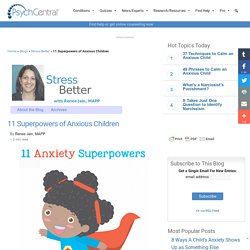

Over-Accommodating a Child's Anxious Emotions Can Backfire. Source: Vladislav Vasnetsov/Pexels Many parents with an anxiety-prone kid become overprotective; Mom and/or Dad will bend over backward to accommodate their child's anxiety by allowing him or her to avoid any situation that triggers anxious emotions.

Although some "parental accommodation" for anxious childhood emotions is healthy and helpful, a growing body of evidence (O'Connor et al., 2020) suggests that too much parental accommodation can make a child's anxiety symptoms worse over time and may lead to debilitating anxiety in adulthood. article continues after advertisement What Is the "Supportive Parenting for Anxious Childhood Emotions" (SPACE) Program?
This parent-based intervention for childhood anxiety is called "Supportive Parenting for Anxious Childhood Emotions" and is commonly referred to by the acronym SPACE. "There are currently two evidence-based treatments for anxiety—medication and cognitive behavioral therapy. How Does SPACE Work? How often did you reassure your child? Icebergs are deceiving because what you see on the surface is usually only a small fraction of what lies below.

Observing the behavior of an anxious child is sometimes like looking at the tip of an iceberg: underlying the anxious behavior are layers of emotions and experiences. Therapists often illustrate this idea with an image like this: While the image above can be eye-opening, there’s a huge assumption that parents can actually recognize that tip of the iceberg or look at a child’s behavior and say, “Yup, that’s anxiety.” Here’s the reality: anxious behavior in children is not uniform. Your child might ask repetitive questions for reassurance and no matter how many times you answer, the question repeats.
Let’s try to understand why anxiety manifests in these ways by taking a deeper dive into each: Let’s not sugarcoat it: Life can be hard for anxious kids.

Even simple, everyday tasks can seem big and scary when they come with sweaty palms, a pounding heart, and the feeling that something — anything, maybe even everything — is about to go horribly wrong. 13 Tips to Support Your Socially Worried Child. Forget Positive Thinking – Try This to Curb Teen Anxiety. “I didn’t get invited to Julie’s party… I’m such a loser.”

“I missed the bus… nothing ever goes my way.” “My science teacher wants to see me… I must be in trouble.” These are the thoughts of a high school student named James. You wouldn’t know it from his thoughts, but James is actually pretty popular and gets decent grades. Unfortunately, in the face of adversity, James makes a common error; he falls into what I like to call “thought holes.” Here’s the thing, all kids blow things out of proportion or jump to conclusions at times, but consistently distorting reality is not innocuous.
Fortunately, in a few steps, we can teach teens how to fill in their thought holes. We Create Our Own (Often Distorted) Reality One person walks down a busy street and notices graffiti on the wall, dirt on the pavement and a couple fighting. Why don’t we just interpret situations based on all of the information? Shortcuts keep us sane by preventing sensory overload. Eight Common Thought Holes. Making Mistakes.
Violence of Children. 11 Ways to Calm a Child's Repetitive Anxious Thoughts. “What if I have no friends to sit with at lunch?”

One anxious thought can repeat in the mind like a vicious broken record. Are you familiar with this phenomenon? If you’re a parent of an anxious child, you might even hear this thought repeated out loud. What can you do to help? When nothing in your verbal toolbox seems to break the cycle of repetitive anxious thoughts, try the power of physical touch. But what if you are not around to give your child a hug when he or she needs it? 1. 2. 3. 4. 5. 6. 7. 8. 9. 4 Jedi Mind(fulness) Tricks to Help an Anxious Child. “The Force is what gives a Jedi his power,” says Obi-Wan Kenobi to Luke Skywalker.

“It’s an energy field created by all living things. It surrounds us and penetrates us. It binds the galaxy together.” (Photo Credit: Levent Konuk / Shutterstock.com) My favorite movies of all time come from the original Star Wars trilogy. Middle school hurt. My parents tried to cleave me from the throes of panic with consistent love and reassurance, but to no avail. So I built one–an impenetrable emotional force shield.
I believed my own words until the plan started to fall apart, and in the end was nothing short of an epic fail. Instead of wielding the Force, I numbed it, particularly the dark side. That bomb went off at age twenty-five. You see, Luke Skywalker is a beacon of strength and a guardian of peace and justice not because he always feels happy and good. By the time Luke reaches the final battle with his father, Darth Vader, in Return of the Jedi, he is a master of mindfulness. 1.